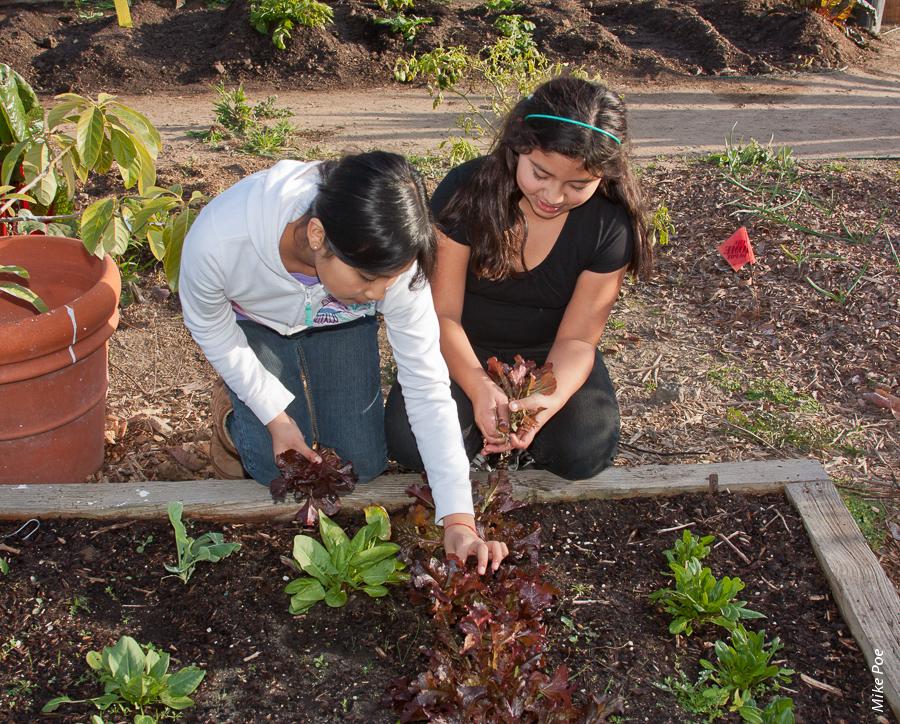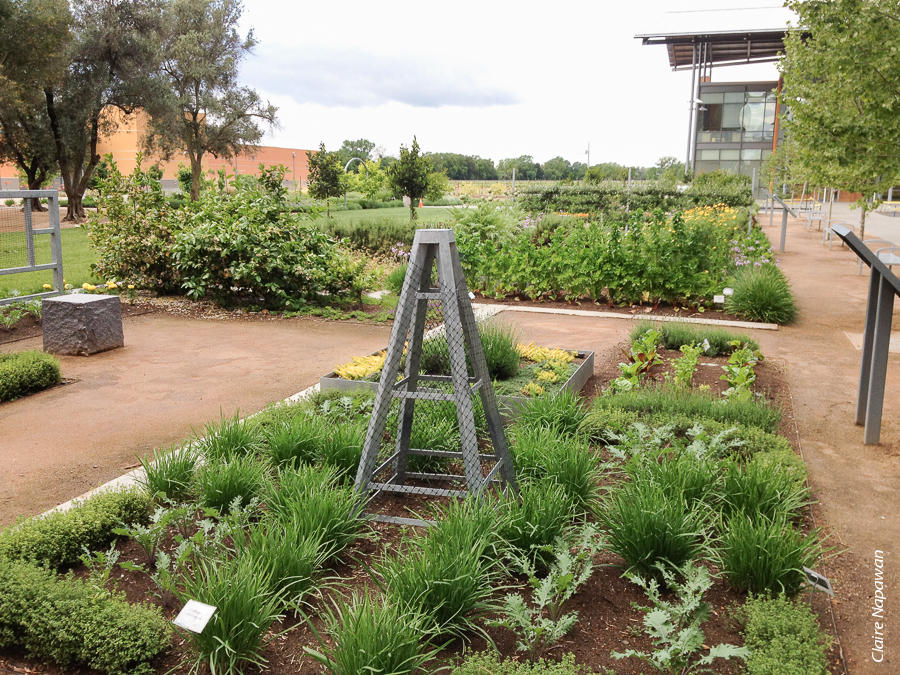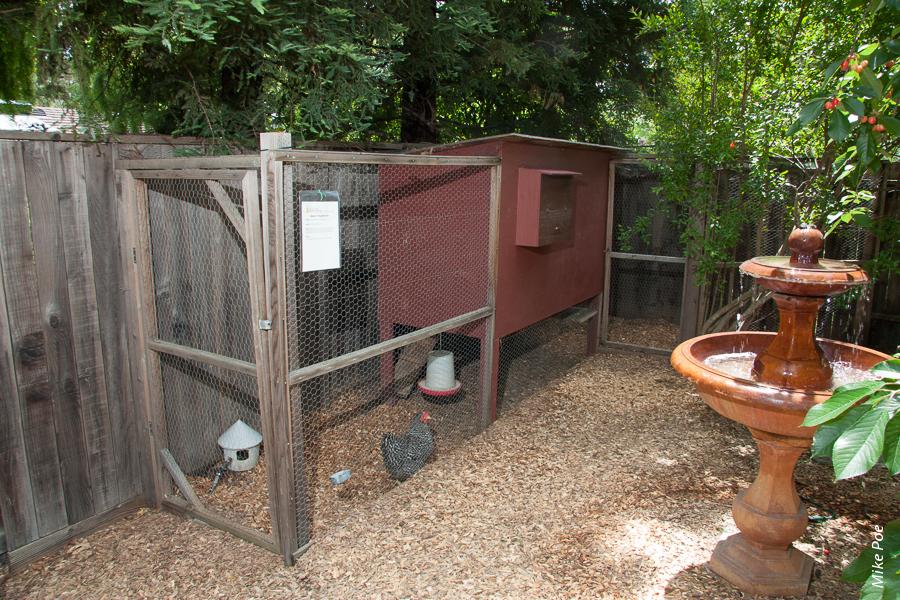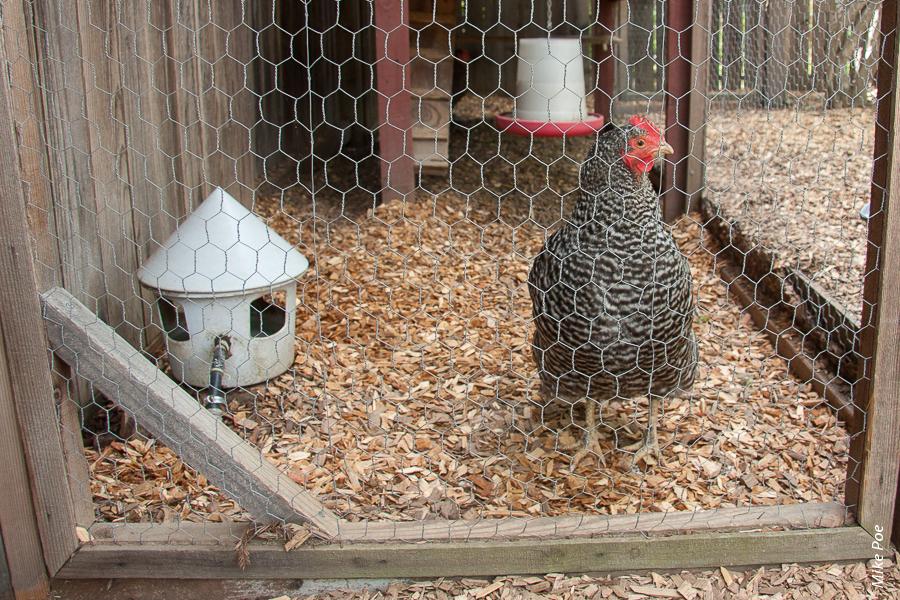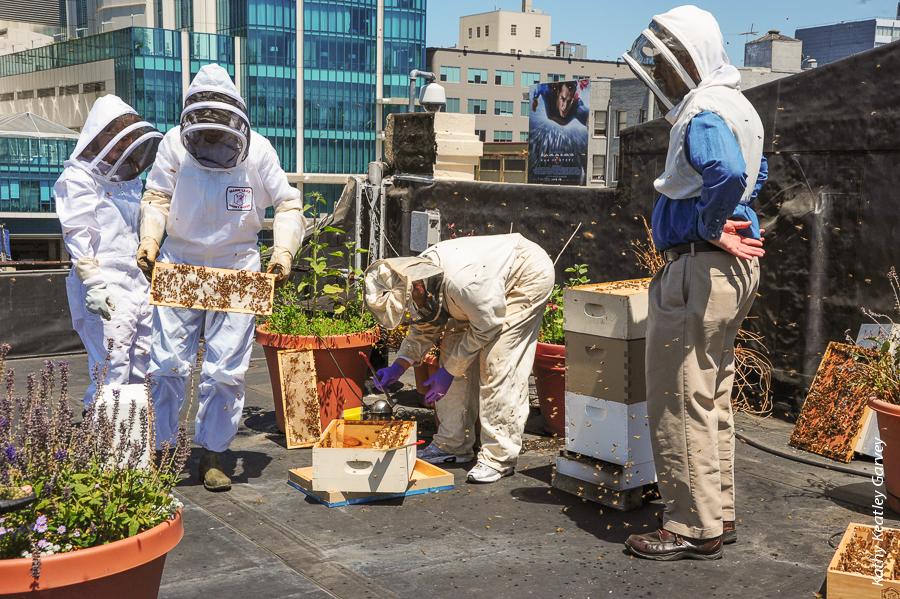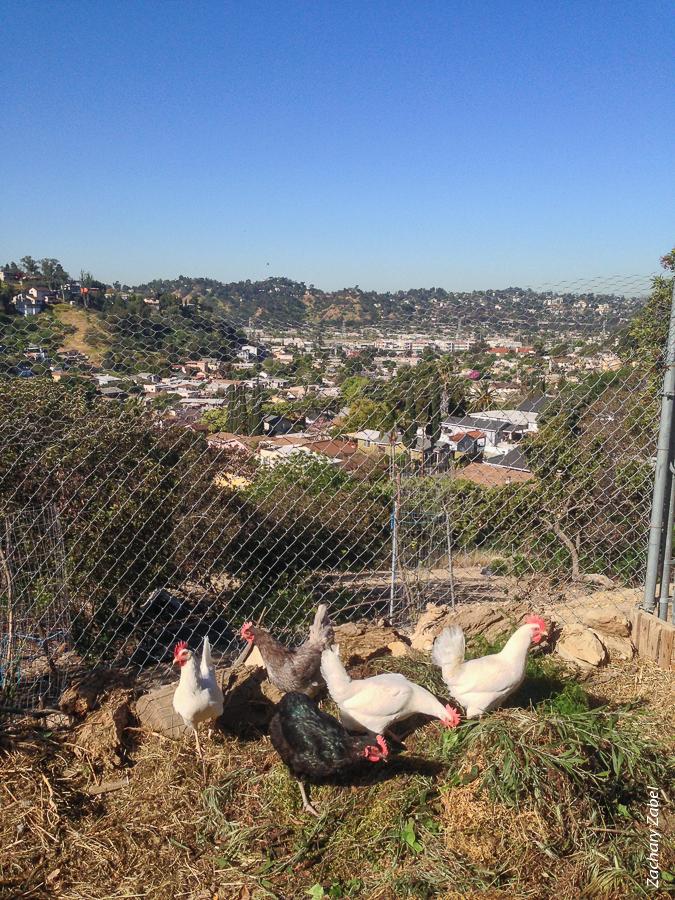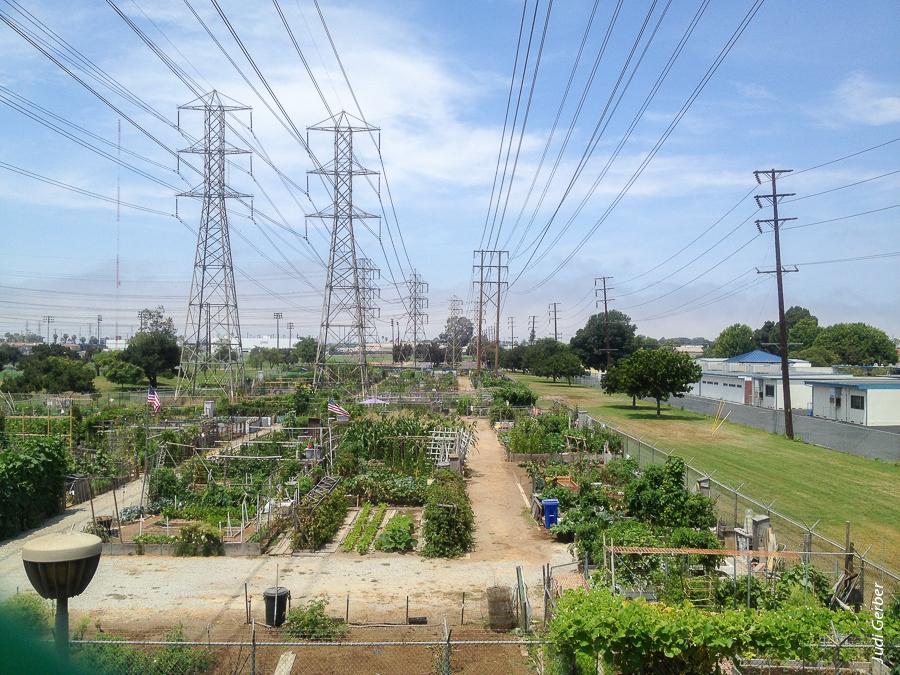All Issues
UC Cooperative Extension helps farming sprout in the city
Publication Information
California Agriculture 67(4):199-202. https://doi.org/10.3733/ca.v067n04p199
Published online October 01, 2013
NALT Keywords
Full text
As the sustainable food movement grows, farming is taking root in California cities from San Francisco to San Diego. Urbanites are asking for — and receiving — municipal approval to plant vegetable gardens in empty lots and under power lines, and to raise backyard chickens and bees. To help the state's urban agriculture thrive, UC Cooperative Extension (UCCE) researchers are working to boost resources and programs for city growers.
“People are passionate about keeping bees, growing their own food, and distributing it to the community,” says Rachel Surls, who recently became the first Sustainable Food Systems advisor in UCCE Los Angeles County and is also a member of the Los Angeles Food Policy Council, which promotes local agriculture, sustainability and healthy food for underserved communities.
But passion isn't enough, and Surls soon learned that reliable information on city farming is lacking. “It became clear that while many people are enthusiastic, we don't know much about the needs of urban agriculture or even what it looks like,” she says.
To help find out, she was the client for a UCLA study of urban agriculture in Los Angeles County (see sidebar on page 202). In addition, she assembled a team that was awarded a 2-year UC Agriculture and Natural Resources (ANR) grant to identify proven benefits of urban farming and to assess ANR's current urban agricultural services as well as needs for the future. The 15-member team includes experts in urban agriculture, small-scale farming, sustainable agriculture, integrated pest management and urban planning.
Urban agriculture is undergoing a revival in California, and research shows that community gardens increase consumption of fresh produce, provide nutrition education and build community.
“Issues like food safety and pest management are important for small, urban growers just as they are for large, rural ones,” Surls says. “Who better than UC ANR and UCCE to say, ‘Here are the best practices’?”
Historical ups and downs
While today's upswing in urban agriculture is new to most of us, the United States has a long history of growing food in the city. Industrial cities in the Northeast used farming to build skills among unemployed workers in the 1890s; the federal government funded subsistence gardens during the Great Depression; and Victory Gardens helped people get enough to eat during the world wars. But as the post-World War II economy boomed, suburbs spread into farmland, and cities set new zoning codes to keep the two land uses separate.
Fast forward to today, and the boundary between cities and farming is beginning to blur again. The 2010s have seen a resurgence of legal urban agriculture in California, including farms and on-site sales of produce and eggs in San Francisco and Berkeley, chickens in Sacramento, and bees and miniature goats in San Diego. In addition, Los Angeles is poised to allow growing food plants in sidewalk strips.
Health and social benefits
These changes in municipal codes are driven by people who embrace green living under local, sustainable and slow food movements as well as by local governments seeking to tap urban agriculture's social benefits. Advocates tout city farming as a remedy for obesity, poverty and other woes. However, these complex issues have many causes. “There's a lot of hype about the health and social benefits,” Surls says. “We wanted to see the data.”
Her team reviewed studies of urban agriculture nationwide and found that, hype aside, there are plenty of well-documented direct benefits that make a strong case for cities to welcome and support farming within their limits. Community gardens boost consumption of fresh produce, can save participants hundreds of dollars per season in food costs, and, along with farmers markets, provide nutrition education that increases healthy cooking and eating.
Farming also builds community in cities. People gather at farmers markets, and come to consensus when planning and working in community gardens. In addition, urban agriculture brings young and old together, and many programs give skills, training and jobs to troubled youths. City farming has individual benefits too, instilling a sense of pride and ownership in participants.
The attractive edible landscaping at the UC Davis Good Life Garden includes vegetables, herbs and flowers that are grown organically and sustainably. In addition, the university shares food and health information via educational signs in the garden.
Next, Surls and her team surveyed UC ANR staff statewide to see how they are currently serving the needs of urban agriculture. Answers include training UCCE Master Gardeners to give edible landscaping workshops, guiding community gardens and small urban growers and advising on urban chicken and beekeeping.
Edible landscaping
Lettuce, peppers and other food plants are popping up in urban spaces from gardens to balconies to roofs. “Every county has a UCCE Master Gardener hotline for questions and suggestions, and edible landscaping is a trending topic,” says UCCE academic coordinator Missy Gable, who directs the UCCE Master Gardener Program, which provides research-based information on sustainable landscaping and disseminates it through the state's more than 5,400 Master Gardeners.
To meet the demand for edible landscaping, the Master Gardeners developed a new “train the trainer” program with a UC ANR grant. Offered at six sites around the state this spring and fall, the 2-day program has drawn hundreds of participants who then trained other Master Gardeners and held workshops for the public. “We want to increase food security by increasing food production in the home landscape,” Gable says.
The training program covers the basics of growing edibles from beginning to end, including landscape design, planting, maintenance — such as irrigation, integrated pest management and crop rotation — and harvest. Another major focus is food safety. “You have to think about proximity to animals, which can carry disease,” Gable says, “and make sure not to prune your crops with the same shears used on plants treated with chemicals that are not food safe.” In addition, the program addresses policies that affect edible landscaping, such as whether corn is allowed in the front yard as well as the restrictions on water use in urban landscapes under California Assembly Bill 1881. Also in the works is an edible landscaping handbook that will be available online.
Backyard hen houses
Chickens are also on the rise in cities, but their fast-growing popularity has raised concerns for their health. “Urban chicken owners generally aren't trained to recognize signs of illness; there are few if any chicken vets in the city, and online forums are not moderated by experts,” says Sarah Stinson, a researcher at the California Animal Health and Food Safety Lab at UC Davis. To help keep home flocks healthy, the lab offers a free diagnostic service that tells people why their chickens died. Then hen keepers can give the diagnosis to a veterinarian, who can treat the rest of the flock.
Backyard flocks are a better fit in the city when they do not include roosters, which can crow loudly day and night, and when chickens are kept in the coop until neighbors wake up. Likewise, sharing eggs can earn goodwill.
Funded by the California Department of Food and Agriculture as a biosecurity measure, this service also gives insight into chicken-keeping trends. Numbers on backyard hens are hard to come by because people who keep them illegally don't report problems and, while urban hens are increasingly legal in California, most people skip registering their flocks. But two indicators suggest a huge jump in urban chickens. “The popularity of online chicken forums has exploded, and we've had a significant increase in chicken submissions over the last 5 years — from about 170 in 2007 to more than 800 in 2012,” says Stinson, who keeps hens herself.
Backyard chickens should be kept in coops that protect them from cats and other urban predators. They also should be fed specially formulated chicken feed, not chicken scratch or scraps.
Besides keeping their flocks disease-free, people should keep hens in coops that protect them from cats and other urban predators, and give them specially formulated chicken feed from feed stores rather than chicken scratch or scraps. And even where chickens are legal, it's a good idea to talk to the neighbors before setting up a coop. Ways to earn goodwill include keeping hens in the coop until neighbors are awake, sharing eggs and, most of all, forgoing roosters, which can crow loudly day and night, and are illegal in some municipalities.
Bees and the city
Today's interest in urban beekeeping is linked partly to the decline of honey bees. While once common, most feral honey bees were knocked out by the Varroa destructor mite that was introduced in 1987. Now, however, their numbers are growing again, partly due to urban beekeeping. “It's a good thing for bees and for pollination,” says Eric Mussen, a UCCE apiculturist at UC Davis. Another benefit of city bees is that people who keep them may be more careful about using pesticides in their gardens.
While bees can be a hard sell in cities, they mix well with people as long as you take their behavior into account. “You want to let bees do their own thing but you should never vex your neighbors,” Mussen says. As with chickens, it's important to talk to neighbors before keeping bees, particularly because some people have life-threatening allergic reactions to bee stings.
Ways to accommodate bees and people in close quarters include installing fences or tall hedges near hives, which redirects the bees' flight path overhead instead of across sidewalks and streets. While many California cities still prohibit or restrict hives, Mussen points out that honey bees and people get along in some of the nation's biggest cities. New York City allows urban hives, for example, and Washington, D.C., began allowing them when Michelle Obama wanted to keep bees at the White House to pollinate her vegetable garden.
To keep up with and anticipate needs as urban agriculture grows in California, Surls and her team are currently interviewing urban growers and planners. “We're asking what they wished they had known so we can identify gaps in services and develop resources to fill them,” she says. Ultimately, her team envisions a comprehensive online portal to provide science-based information on urban agriculture. Says Surls, “When it comes from UC, it's a trusted resource.”
Honey bees can be a good fit even in a dense city when their flight paths are redirected away from sidewalks and streets, and when no one nearby is allergic to bee stings. Urban hives may also help stem the honey bee decline.
A snapshot of urban agriculture in Los Angeles
The state of urban agriculture — from who's doing what and where, to what they need to do it well — recently became clearer in Los Angeles, thanks to a 6-month capstone project by a team of UCLA graduate students in urban planning. The project captured the range of city farming throughout the county, and included identifying and mapping nearly 1,300 urban agriculture sites, documenting the agriculture-related regulations in the county's 88 cities, and giving recommendations on how to support farming in cities.
Collectively, people in LA cities grow food plants in school and community gardens as well as in yards and under power lines, and keep rooftop beehives and backyard chickens. But what's allowed varies tremendously from city to city. To streamline the current maze of confusing and contradictory regulations, the researchers called for making health and zoning codes clearer and more consistent. “Model ordinances, which are a common urban planning tool, could be developed to make it easier for cities,” says Stephanie Pincetl, director of the California Center for Sustainable Communities at UCLA, who was an advisor on the project.
Researchers verified and mapped 118 community gardens, 761 school gardens, 211 nurseries and 171 farms in Los Angeles County.
Another barrier to urban agriculture is lack of knowledge. “Many people are so disconnected from agriculture that they don't know a thing about growing food,” Pincetl says. “They don't know about soil types or vulnerability to disease and drought.” To help them learn, the researchers recommended creating an online database of agricultural resources and best practices geared toward urban gardeners and growers.
In addition, city growers face challenges that their rural counterparts don't have to contend with. “There are enormous obstacles like expensive water, and soil and air pollution,” Pincetl says. Soil can be contaminated by lead paint and industrial chemicals, while car exhaust and copper from brake linings may contaminate lettuce and other food plants in sidewalk strips. “There's a lot of room to grow food in the city — there are thousands of miles of street — but you have to be judicious,” she says, adding that sidewalk strips may be better suited to citrus trees, which are tidy and produce fruit that is protected by a peel.
Regulations for backyard flocks vary widely among municipalities, and could be streamlined with a model code that includes best practices for keeping fowl.
Another consideration is that while urban agriculture can build community, Pincetl points out that it can also create conflict. “People disagree about using pesticides in community gardens, and there can be tension if someone doesn't weed,” she says.
The researchers' findings are presented in the June 2013 report Cultivate L.A: An Assessment of Urban Agriculture in Los Angeles County ( http://cultivatelosangeles.org/ ). “This is a great resource for developing programs,” says Rachel Surls, the Sustainable Food Systems Advisor at UCCE Los Angeles who was the project client. “Our role is guidance and this will help UCCE provide science-based information to inform the issues.”
—Robin Meadows



